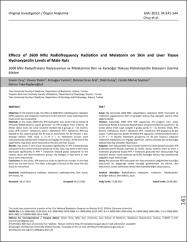Effects of 2600 Mhz Radiofrequency Radiation and Melatonin on Skin and Liver Tissue Hydroxyprolin Levels of Male Rats

View/
Access
info:eu-repo/semantics/openAccessDate
2023Author
Oruç, SinemDelen, Kevser
Yardım, Armağan
Kuzay, Dilek
Seymen, Cemile Merve
Kaplanoğlu, Gülnur Take
Metadata
Show full item recordCitation
Oruç, S., Delen, K., Yardım, A., Aral, B. S., Kuzay, D., Seymen, C. M., & Kaplanoğlu, G. T. (2023). Effects of 2600 Mhz Radiofrequency Radiation and Melatonin on Skin and Liver Tissue Hydroxyprolin Levels of Male Rats. Gazi Medical Journal, 34(2).Abstract
Objective: In the present study, the effect of 2600 MHz radiofrequency radiation (RFR) exposure, and melatonin treatment on skin and liver tissue hydroxyproline (Hyp) levels were evaluated. Methods: In the study, 2600 MHz RFR application was performed by Rohde & Schwartz Radiofrequency signal generator via ETS-Lindgren horn antenna. 36 Wistar albino male rats were randomly divided into 6 groups (n = 6); Control, sham, RFR, control + Melatonin, Sham + Melatonin, RFR + Melatonin. RFR was applied to the related groups for 30 days (5 days/week) for 30 minutes a day. Average electric field value is 21.74 V / m. Melatonin groups were subcutaneously injected with melatonin (10 mg/kg) for 30 days. At the end of the experiment, Hyp levels were measured in the skin and liver tissues. Results: Hyp levels in skin tissue decreased significantly in RFR treated groups compared to the control and sham groups (p <0.05). Also, Hyp levels in skin tissue decreased significantly in RFR + melatonin treated group compared to the control, sham and sham+melatonin groups. No changes in Hyp levels in liver tissue were determined. Conclusion: In this study, RFR exposure leads to significant changes in skin Hyp levels but not liver tissue. This effect is thought to be due to the closer the skin tissue to the surface. ©Copyright 2023 by Gazi University Medical Faculty.
Source
Gazi Medical JournalVolume
34Issue
2Collections
- Yayın Koleksiyonu [16]

















